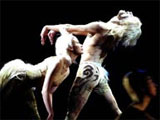 "Tibetan Antelope", a dance drama with the universal themes of environmental protection, life and love, will play at the Poly Theater from Thursday to Saturday.
"Tibetan Antelope", a dance drama with the universal themes of environmental protection, life and love, will play at the Poly Theater from Thursday to Saturday.
Chinese choreographers Chen Huifen and Wang Yong were inspired by the life and tragic fate of the Tibetan antelopes when they went to southwest China's Tibet Autonomous Region last year and responded with the innovative and touching dance show.
"On the plateau, we suffered both physically and mentally," said Wang. While the physical suffering came from altitude sickness, mentally they were deeply saddened by the plight of the Tibetan antelopes, hunted for their wool.
The Persian word "Shahtoosh" is commonly translated as the "king of wool." The description is no hyperbole. Shahtoosh is gossamer-like in weight and texture, soft as a baby's skin, yet warm. It is so fine that even a large shawl can be pulled with ease through a finger ring, which gives it its other name: "Ring Shawl."
Shahtoosh shawls sell for up to US$10,000 or more, and have become the rage among the rich, famous and fashionable.
However, this luxury is supported by death: Three to five Tibetan antelopes are slaughtered to provide the 300 grams to 600 grams of raw wool needed to produce a single shawl. The wool can not be separated easily from the skin so the animals are killed.
How this fad started is unclear. What is certain is that, at the current level, the Shahtoosh craze drives a trade that the Tibetan antelope cannot sustain.
Despite legal protection and trade bans, the burgeoning Western market for Shahtoosh has caused a dramatic increase in poaching since the late 1980s.
In 1900, the population of Tibetan antelopes is estimated to have been a robust 1 million. Now, less than 70,000 still live on the plateau.
"Images of Tibetan antelopes keep walking, running and jumping in my mind. They are slaughtered not knowing what's happening, and I could not help reviving all these issues on the stage," said Wang's wife Chen.
Featuring prize-winning dancers Liu Zhen and Wu Jiaqi, music by Liu Tong, sets by Gao Guangjian, lighting by Shao Xiaolan and costumes by Li Ruiding, the four-act dance drama, plus a prelude and a coda, vividly interprets a Tibetan antelope's entire life.
The gentle Tibetan antelopes are born and grow up in the vigorous environment of the plateau.
When both the male and female Tibetan antelopes are in heat, the males fight for the right to mate with the females. They live a harmonious life with all the other animals in the beautiful highlands.
When the female antelopes become pregnant, they start a long journey to the high peaks to give birth to the next generation.
Wang and Chen, a talented choreographer couple, have co-operated on several prize-winning dance dramas including the grand piece Mazu Goddess which won the Golden Lotus Award in the National Dance Drama Competition.
Their innovative and true-to-life choreography in Tibetan Antelope fully displays the lovely antelopes' movements, habits and characteristics in the one-and-a-half-hour show, without resorting too much to human elements.
In former Chinese dance works featuring animals, the choreographers preferred to create human-like characters and make a complete story, or represent some touching relationship between humankind and animals, said Wang. "But we prefer to present the lives of the animals on the stage and through them tell the audience how they live."
If audiences have been deeply imprinted with the graceful white swans from the classic ballet Swan Lake and the charming peacock dance performed by well-known Chinese dancer Yang Liping, they will be definitely impressed by the vivid images of Tibetan antelopes at the show.
Chen said: "Thanks to the talented dancers who understand my choreography well, the audiences can see an interpretation of real antelopes on the stage, not just people in antelope costumes."
Liu plays the lead male Tibetan antelope and Wu is the female. Both are established dancers in China, but devote great efforts to the show.
To imitate the antelopes, they have to lower their waists, as in a bow, and keep their hands like hooves. The choreographers also require them to "stand in the antelopes' hooves" so as to present innocent eyes like the antelopes themselves.
"I have performed several full-length dance dramas in many roles, but this is the most difficult one," said Liu, graduate from the Beijing Academy of Dance.
The difficulty comes not only from the manners and movements of the animals, which are awkward for people, but also from how to express their inner moods and emotions.
"It seems depicting a man is much easier than interpreting an animal's natural life," Liu said.
The show also features other animals living on the plateau, such as Tibetan kiang, wild yak and black-necked crane.
The large cast of about 70 young dancers portrays all these creatures as true to life as possible.
After seeing the rehearsal, Zi Huayun, vice-president of the Chinese Dancers Association, was quite satisfied. "I was deeply touched by the show. It is different from those stage dramas which have a gorgeous appearance but weak dance numbers."
Li Chengxiang, the former president of the National Ballet of China, said he likes the piece very much.
"Choreographers pursue individual body language and innovative structures. It is difficult, but these choreographers have achieved it in this show. They successfully created an image of the Tibetan antelope which has never been seen on the dance stage before," said Li.
(CRI November 21, 2002)
|

